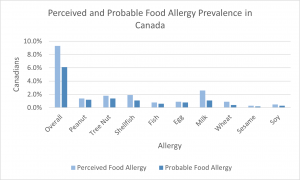Food allergies appear to be an increasing worry to the Canadian public, with common allergens such as nuts, milk, and eggs being frequently used in foods of all cultures. Some allergic reactions produce the immunoglobulin E antibody, which can lead to life-threatening anaphylactic shock. The question is whether allergy prevalence is rising alongside these concerns.

Some Common Food Allergies Source: NIAID
Health Canada and AllerGen NCE supported the University of Calgary and the University of Waterloo’s research to estimate the prevalence of food allergies in the country. The study surveyed 5,784 Canadian households in 2016, asking people to report their food allergies.
The percentage of Canadians that had a perceived food allergy, claimed by self-report, was noticeably higher than the percentage with a probable food allergy, supported by family history or physician diagnosis.

Food Allergy Prevalence in Canada Source of Data: Government of Canada
Clarke et al. compared these results to data from 2010, observing a noticeable increase in overall food allergy claims (7.1% to 9.3%), but only a minimal change in supported food allergy claims (5.9% to 6.1%).
While the actual prevalence of food allergies did not rise significantly, Clarke et al. states that the increase in self-reported allergies is likely due to raised awareness.
Continuing to spread awareness on food allergies is actually beneficial, as they are not curable. Severe allergic reactions are treated by an epinephrine injection in emergency situations, making educating people and properly labelling food products that much more important.


